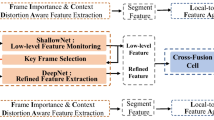Abstract
An experience oriented, physiology based video digesting method is proposed, and its applicable video types are experimentally examined. The proposed method extracts shots that have made audiences most attentive by analysing two attention measures obtained from heart activity while watching. To assess its applicable types, three original videos that convey distinctive emotional quantity were prepared, and three test digests—shots selected randomly, subjectively and by the proposed method—were generated from each original. Then, the proposed method was evaluated not only by its precisions against the subjective selection, but also by digest viewing experience from subjective scores and a psychophysiological measure. The experiment showed that the proposed method was promising for those with arousing, event-driven contents. It was also suggested that use of multiple evaluation measures is important to exhibit applicability of a digesting method.
Access this chapter
Tax calculation will be finalised at checkout
Purchases are for personal use only
Preview
Unable to display preview. Download preview PDF.
Similar content being viewed by others
References
Truong, B.T., Venkatesh, S.: A video abstraction: A systematic review and classification. ACM Trans Multimedia Computing, Communications & Applications 3(1), Article 3 (2007)
KDDI R&D Labs: Highlight creater, http://mmm.kddilabs.jp/en/hc/gui.html
Money, A.G., Agius, H.: Automating the extraction of emotion-related multimedia semantics. In: 19th British Computer Society Human Computer Interaction (BCS HCI) Group Annual Conf. (2005)
Arifin, S., Cheung, P.Y.K.: User attention based arousal content modeling. In: IEEE Int. Conf. Image Processing, ICIP 2006, pp. 433–436 (2006)
Hanjalic, A., Xu, L.Q.: User-oriented affective video content analysis. In: IEEE Workshop on Content-Based Access of Image and Video Libraries, CBAIVL 2001, pp. 50–57 (2001)
Kang, H.B.: Affective content detection using HMMs. In: ACM Int. Conf. Multimedia, MM 2003, pp. 259–262 (2003)
Xu, M., Chia, L.T., Jin, J.: Affective content analysis in comedy and horror videos by audio emotional event detection. In: IEEE Int. Conf. Multimedia and Expo. 2005, pp. 622–625 (2005)
Irie, G., Hidaka, K., Miyasato, N., Satou, T., Taniguchi, Y.: A video skimming method for detecting “laughter” scenes in consumer generated videos. J. Institute of Image Information and Television Emgineers 62(2), 227–233 (2008) (in Japanese)
Toyosawa, S., Kawai, T.: An assemblage of impressive shots - a video digesting method based on viewer’s heart activity. In: IASTED Int. Conf. Internet and Multimedia Systems and Applications, IMSA 2008, pp. 107–112 (2008)
Healey, J., Picard, R.W.: Startlecam: a cybernetic wearable camera. In: Proc. Second Int. Symposium on Wearable Computing, pp. 42–49 (1998)
Aizawa, K., Ishijima, K., Shiina, M.: Summarizing wearable video. In: Proc. 2001 Int. Conf. Image Processing, ICIP 2001, vol. 3, pp. 398–401 (2001)
Shibata, Y., Takahashi, Y., Kamada, M., Osawa, E., Kimura, H., Miura, M.: Weight DS extension for affect-based content characterization. MPEG 88/M5481, ISO/IEC JTC1/SC29/WG11 (1999)
Joho, H., Jose, J.M., Valenti, R.: Exploiting facial expression for affective video summarisation. In: ACM Int. Conf. on Image and Video Retrieval, CIVR 2009, pp. 1–8 (2009)
Ong, K.M., Kameyama, W.: Classification of video shots based on human affect. J. Institute of Image Information and Television Engineers 63(6), 847–856 (2009)
Anttonen, J., Surakka, V.: Emotions and heart rate while sitting on a chair. In: Proc. ACM Conf. Computer Human Interaction, CHI 2005, pp. 491–499 (2005)
Niizeki, K., Nishidate, I., Uchida, K., Kuwahara, M.: Unconstrained cardiorespiratory and body movements monitoring system for home care. Medical and Biological Engineering and Computing 43(6), 716–724 (2005)
Lang, P.J., Bradley, M.M., Cuthbert, B.N.: International affective picture system (IAPS): Affective ratings of pictures and instruction manual. Technical report, University of Florida, Gainesville, FL (2008)
Bradley, M.M., Codispoti, M., Cuthbert, B.N., Lang, P.J.: Emotion and motivation I: Defensive and appetitive reactions in picture processing. Emotion 1(3), 276–298 (2001)
Leinhart, R.: Comparison of automatic shot boundary detection algorithms. In: Proc. SPIE Storage and Retrieval for Image and Video Database VII, pp. 290–301 (1999)
Öhman, A., Hamm, A., Hugdahl, K.: Cognition and the automatic nervous system. In: Cacioppo, J.T., Louis, L., Berntson, G.G. (eds.) Handbook of Psychophysiology, 2nd edn. pp. 533–575. Cambridge University Press, New York (2000)
Task Force of the European Society of Cardiology & The Northern American Society of Pacing, Electrophysiology: Heart rate variability: Standards of measurements, physiological interpretation, and clinical use. European Heart Journal 17, 354–381 (1996)
Toyosawa, S., Kawai, T.: Video digest based on heart rate. In: IASTED Int. Conf. Visualization, Imaging, and Image Processing, VIIP 2007, pp. 15–20 (2007)
Nakajima, Y.: Psychology of Visual Perception—Approaches to Effective Multimedia Application. Saiensu Sha, Tokyo (1996) (in Japanese)
Andreassi, J.L.: Psychophysiology: Human Behavior & Physiological Response, 5th edn. Lawrence Erlbaum, New Jersey (2007)
Picard, R.W., Vyzas, E., Healey, J.: Toward machine emotional intelligence: Analysis of affective physiological state. IEEE Trans. Pattern Anal. & Mach. Intell. 23, 1175–1191 (2001)
Author information
Authors and Affiliations
Editor information
Editors and Affiliations
Rights and permissions
Copyright information
© 2010 Springer-Verlag Berlin Heidelberg
About this paper
Cite this paper
Toyosawa, S., Kawai, T. (2010). An Experience Oriented Video Digesting Method Using Heart Activity and Its Applicable Video Types. In: Qiu, G., Lam, K.M., Kiya, H., Xue, XY., Kuo, CC.J., Lew, M.S. (eds) Advances in Multimedia Information Processing - PCM 2010. PCM 2010. Lecture Notes in Computer Science, vol 6297. Springer, Berlin, Heidelberg. https://doi.org/10.1007/978-3-642-15702-8_24
Download citation
DOI: https://doi.org/10.1007/978-3-642-15702-8_24
Publisher Name: Springer, Berlin, Heidelberg
Print ISBN: 978-3-642-15701-1
Online ISBN: 978-3-642-15702-8
eBook Packages: Computer ScienceComputer Science (R0)




